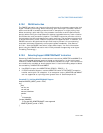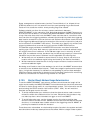
Vol. 3 8-63
MULTIPLE-PROCESSOR MANAGEMENT
PackageProcessorMask[0] = ProcessorMask;
For (ProcessorNum = 1; ProcessorNum < NumStartedLPs; ProcessorNum++) {
ProcessorMask << = 1;
For (i=0; i < PackageNum; i++) {
// we may be comparing bit-fields of logical processors residing in different
// packages, the code below assume package symmetry
If (PackageID[ProcessorNum] == PackageIDBucket[i]) {
PackageProcessorMask[i] |= ProcessorMask;
Break; // found in existing bucket, skip to next iteration
}
}
if (i ==PackageNum) {
//PACKAGE_ID did not match any bucket, start new bucket
PackageIDBucket[i] = PackageID[ProcessorNum];
PackageProcessorMask[i] = ProcessorMask;
PackageNum++;
}
}
// PackageNum has the number of Packages started in OS
// PackageProcessorMask[] array has the processor set of each package
c) Using the list of CORE_ID to count the number of cores in a MP system and construct, for each
core, a multi-bit mask corresponding to those logical processors residing in the same core.
Processors in the same core can be determined by bucketing the processors with the same
PACKAGE_ID and CORE_ID. Note that code below can BIT OR the values of PACKGE and CORE ID
because they have not been shifted right.
The algorithm below assumes there is symmetry across package boundary if more than one socket
is populated in an MP system.
//Bucketing PACKAGE and CORE IDs and computing processor mask for every core
CoreNum = 1;
CoreIDBucket[0] = PackageID[0] | CoreID[0];
ProcessorMask = 1;
CoreProcessorMask[0] = ProcessorMask;
For (ProcessorNum = 1; ProcessorNum < NumStartedLPs; ProcessorNum++) {
ProcessorMask << = 1;
For (i=0; i < CoreNum; i++) {
// we may be comparing bit-fields of logical processors residing in different
// packages, the code below assume package symmetry
If ((PackageID[ProcessorNum] | CoreID[ProcessorNum]) == CoreIDBucket[i]) {
CoreProcessorMask[i] |= ProcessorMask;
Break; // found in existing bucket, skip to next iteration
}


















